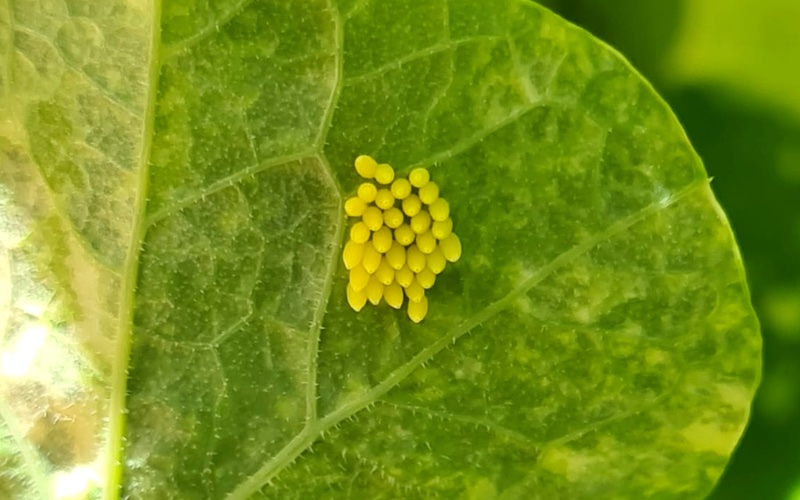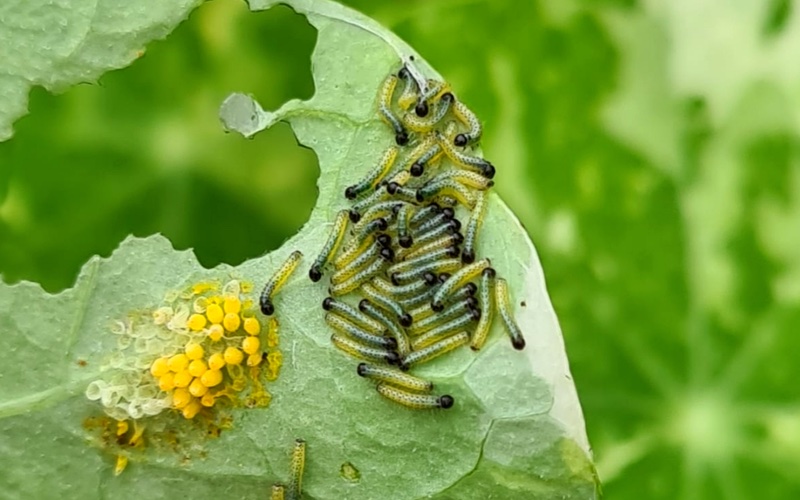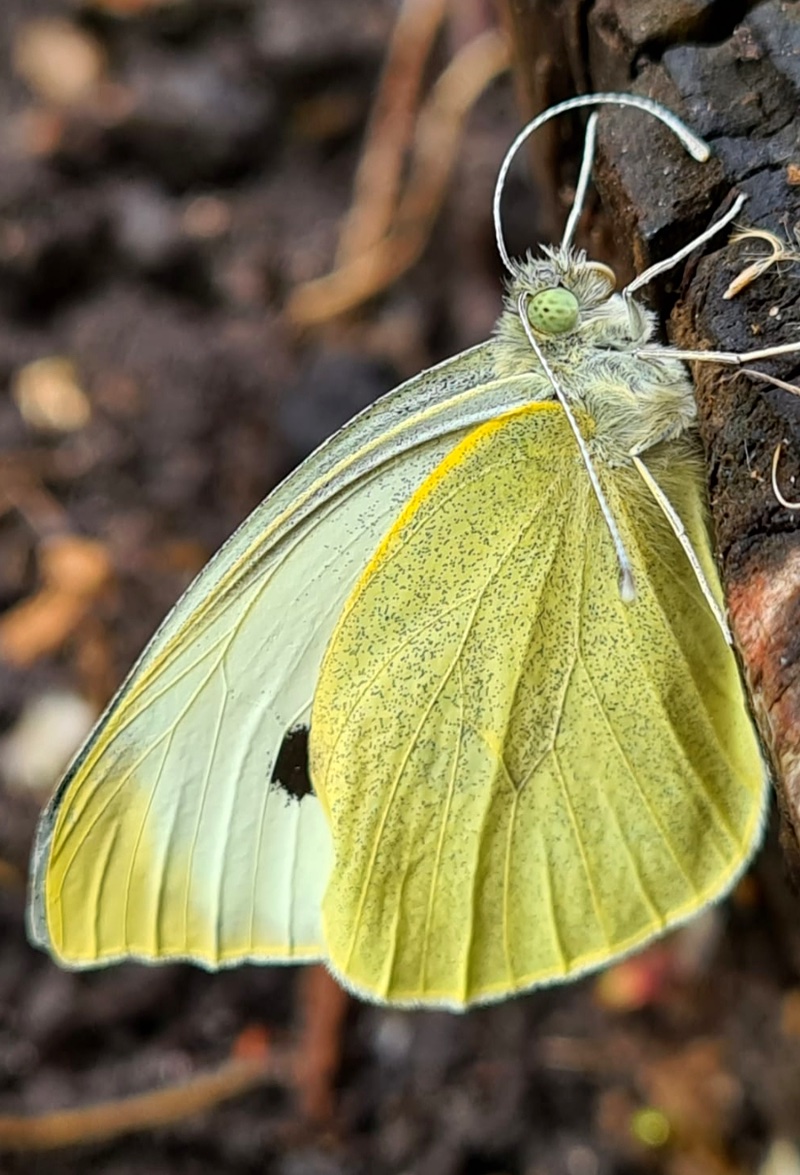THE LANDSCAPING SOLUTIONS BLOG
Welcome to our Blog. Inspiration, updates and industry trends from the team at Landscaping Solutions.
NATURE’S SPOILS
Landscaping Solutions MD Ben West details the ‘rewilding’ of his own garden, from which he, his family and the local wildlife have already reaped rewards.

Rewilding your garden greatly benefits local wildlife.
Last month, we explored the concept of rewilding as an antidote to biodiversity loss and mitigation against the most damaging effects of climate change. I promised to share a snapshot of my garden’s ‘rewilding’ journey, which has so far consisted mainly of adopting a more relaxed attitude to maintenance practices and allowing ‘weed’ species to establish alongside ornamentals.
This approach has greatly benefitted local wildlife and helped my family develop a deeper connection to nature. Through learning the traits and practical applications of the various wild plants that have taken up residence, they have a visceral understanding of nature’s interconnectedness and their place therein. Modern life lived through these eyes is a blessing and a curse. There is truly never a dull moment.
Early in the year, hairy bittercress, dandelion and sow thistle add cleansing and nutritional value to our salads. We rejoice in the emergence of wild garlic and include it in all our cooking. Bright rays of flowering coltsfoot attract the first insects of spring such as the intriguing bee fly. Flowering ground ivy, herb robert and white dead nettle provide uplifting herbal teas.
Moth caterpillars start to show with angle shades feeding on self-seeded buddleia and broad- bordered yellow underwing hiding amongst patches of Cleavers. This plant epitomises the rising of the sap and we drink its juices to cleanse our lymphatic system and shift our metabolisms out of their winter torpor.
Orange tip butterflies are attracted to garlic mustard and we share their caterpillars’ liking for its leaves. They also lay eggs on cuckoo flower which lends a wasabi kick to our salads. Nettles have become a staple food now. Full of nutrients, they combine with fresh vegetables to form the basis for our favourite soup and also feed the larva of the Vanessid butterflies; Red Admiral, Small Tortoiseshell, Comma, Peacock and Painted Lady. Their split stems are weaved together to form cord from which trinkets are dangled from children’s necks and wrists.
Bird nesting begins in earnest and our ivy clad fence is well appreciated. Swift boxes set in the brickwork of our gable end fail to attract their target species but are taken up by house sparrows which enjoy the seeds of self-sown oxalis in the borders. Their constant chattering, at odds with the melancholy flute of the blackbird and the quicksilver outpourings of the blackcap in the willow, form the soundtrack to summer.
We embrace unloved elder by making refreshing summer drinks with its flowers and later medicinal syrups with its berries - blackbird and blackcap love it too. The plants that attract the most life are those that have found their own way here, none more so than the much maligned ragwort which is the centre of all insect activity throughout its long flowering period. Burnet companion, mother of pearl and cinnabar moths (and their caterpillars), gatekeeper and meadow brown butterflies and a host of parasitic wasps, hoverflies and bee species are in constant orbit.
I let fade away anything that fails to fend for itself and allow survivors to thrive; purple toadflax is one such survivor and attracts streams of bees through summer including the charismatic wool carder bee. By night, it is festooned with mother of pearl moths and garish toadflax brocade moth caterpillars. The almost identical larvae of the mullein moth can be found feeding on the foliage of its self - seeded namesake alongside pupating ladybird larvae. Shield bugs are up to no good in the shadows; stag beetles stick to the bricks of the house and demoiselles, damselflies and dragonflies clatter through the deepening foliage.
All life is here amongst these summer weeds. Wild medicinal herbs turn up and are infused to make teas: yarrow for sore throats, plantain for coughs, fennel for digestion and mugwort for lucid dreaming. Others are harvested and preserved in alcohol as tinctures to last through the winter: dock root, St John’s wort flowers and prickly lettuce leaves will treat everything from excitability to lethargy. Prickly lettuce also provides food for small ranunculus moth larvae. The reviled creeping thistle is a great nectar source for late summer insects and now attracts brown hairstreak butterflies to the garden. Grass snakes slither into the compost heap to lay eggs and hunt for rodents.
Moth numbers are peaking and a trap set up at night is a revelation. We are dazzled by the diversity of colours, patterns textures and forms. As summer flowers fade into autumn, dark bush crickets continue to fill the night air with whispering chirrups. At this time, ivy comes into its own. Its late emerging flowers are a major fuel source for insects. Stand beside a spunk scented spray on a sunny day in early autumn to see insect theatre play itself out before you. We really must regain our reverence for this plant.

Large white butterfly eggs.
One image of the unfurling year sticks in my mind. In the spring, I scattered nasturtium seeds in the corner of a raised planter and the rapidly developing foliage became a welcome addition to salads and pesto. Large white butterflies came to lay eggs on the undersides of the leaves. A great life lesson in lockdown for the kids as we observed the eggs through to the larval stage.

Emerging caterpillars on the underside of a nasturtium leaf.
The kids liked the fact we shared the caterpillars love of the peppery vegetation. As they dispersed to pupate, we searched for, and found, a cocoon and marvelled as the emerging imago pumped up its wings and flew away to continue the cycle.

Large white adult Imago.
I wonder if, by embracing rewilding, we are like the caterpillar that, having stripped its food- plant bare and seemingly painted itself into a corner, now undergoes a strange and remarkable metamorphosis to emerge as a useful enhancement to the ecosystem and a jewel for the eye.
One thing is for sure; if the garden had been weeded, much of this richness of life would have been lost and never had the chance to enrich our lives so profoundly.
You can continue to follow Ben’s journey on Instagram: @wearewherethewildthingsare
CHANCE FOR CHANGE - REVIEWING OUR BUSINESS PRACTICES
Rather than going back to the way things were before COVID-19, Landscaping Solutions MD Ben West says we now have a chance to review our business practices.

“Stop the world I want to get off!” We have probably all said it. The current cessation of ‘business as usual’ offers us all the opportunity for serious contemplation on the trajectory of our species. A rare period of respite from the rat race. COVID-19 has enabled us to step outside ‘the machine’ for a new perspective. A chance to make collective changes to it or personal changes to our lives within it. We are usually so seduced by its gears and gadgets we fail to pay full attention to its failings. Perhaps that’s why the children have been leading the way. Not yet indoctrinated, they are free to see its inner workings with unfettered clarity. Witness how they turned away in disgust upon seeing how all things are mangled up in its motors.
The manner in which the machine has been so swiftly brought to its knees is alarming and, in light of the looming climate situation, highly likely to reoccur. Do we really want to continue with business as usual? Can we reorganise ourselves in a way that works harmoniously with nature and recognises humanity’s role in the web of life, a key part of the puzzle rather than a puzzled interloper?
All the recent turmoil - Brexit, COVID-19, climate change - sees humanity at a crossroads, forced to reflect on the next step. What kind of creatures are we? What kind of creatures do we want to be? What kind of world do we want to live in? What relationships do we wish to cultivate with all other creatures and our planet? Do we really want business as usual, as destructive as that has been?
It’s also time for our industry to reflect on these questions. How much of what we have achieved through landscaping and design has been beneficial? For every client with a ‘no maintenance’ outdoor room, every unsustainable show garden, every neatly manicured park, there’s a child labourer, a polluted waterway, a displaced aboriginal or a degraded peat bog. How does this make us feel? Can we continue to turn a blind eye? What do the young people we so desperately covet make of our industry? Are they enamoured with its current state? We need to reimagine ourselves so as to be as attractive as possible to the best of their talent, those wanting to join a movement leading the way and making a difference.
Humanity has the tools to shape its visions, God-like in its ability to manipulate itself, culture and landscape. First, it must clearly define the vision for which it strives. Much current decision making is under the stewardship of those exploiting the planet and its inhabitants in order to turn a short-term profit or maintain power. Will heightened awareness of the planet’s plight and its exploited societies and cultures reach enough of a crescendo to turn the tide?
Rather than business as usual we need a paradigm shift. Without structural revolution we are due to experience more of the same, but exponentially worse. How can we allow ourselves to consider going back to business as usual? Let’s use this time constructively by listening to what nature is telling us and then planning how to emerge transformed. People are looking for leadership. As landscape professionals, we are closer to nature than most and therefore better able to understand what the ‘new world’ needs to look like in order to go forward in a sustainable and regenerative manner. It is our duty to win over as many hearts and minds as possible. If we fail to rise to the challenge, there may soon be no business to go back to.